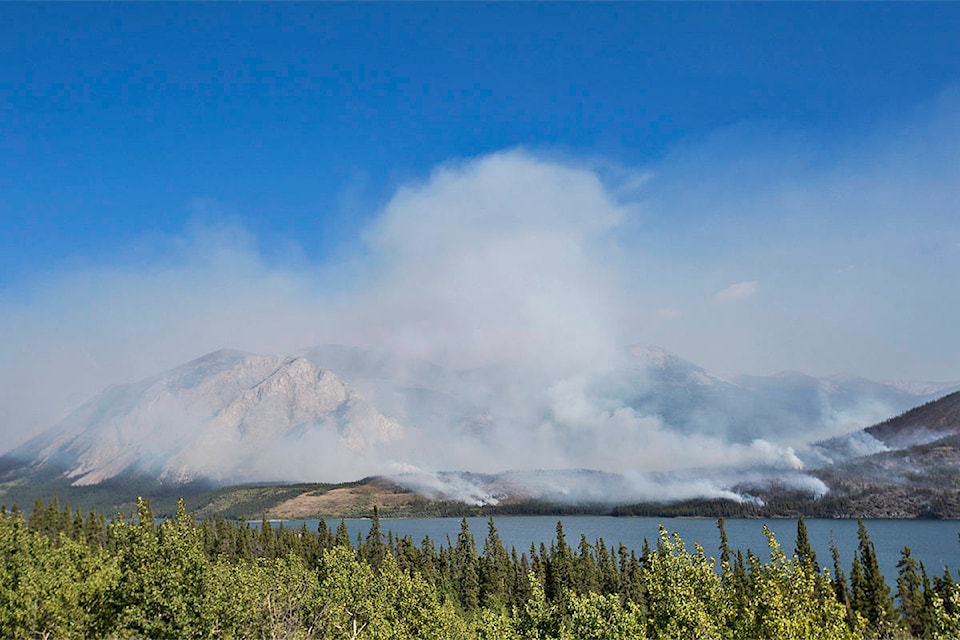Out-of-control wildfires are the greatest threat to the safety of the City of Whitehorse and its citizens, council heard at the Feb. 18 standing committees meeting.
The findings are part of a hazard identification and risk analysis (HIRA) study commissioned by the city and undertaken by Calian Emergency Management Solutions. The study identifies 28 potentially dangerous natural and man-made incidents.
In the report, possible disasters were ranked from 1 to 5 for their likelihood, which takes into account how often something has happened in the past, along with predictive trends, with one being “rare” and five being “almost certain.”
They were also graded by their potential consequences, with 1 being “negligible” and resulting in “minor first aid incidents” with little to no damage to systems and infrastructure, and 5 being “catastrophic,” causing “widespread death or illness” permanent damage or destruction to infrastructure, and “overwhelming” financial consequences.
The consequence and likelihood scores were then multiplied together to get an and overall “risk score” which was defined as “the likelihood of harm occurring with an indication of how serious that harm could be.” An event with a risk score of 5 is “rare”, 15 “possible”, and 25 “almost certain.”
An out-of-control forest fire — similar, say, to the one that decimated Fort McMurray, Alta., in 2017 — had a risk score of 20, making it “likely” to occur, the report says, with a level 5 grade of consequence.
While this might come as a surprise to the public, said deputy fire chief Chris Green, it’s not a surprise to people in emergency response or wildfire management.
“We’ve been working hard to mitigate these risks already,” Green said.
Peter O’Blenes, director of infrastructure and operations for the city, said the study will not mean more money for wildfire programs, such as firesmarting and fuel abatement.
The city already has $700,000 budgeted over the next three years for those programs, with $200,000 budgeted for this year, plus $136,000 in carry over from money budgeted for firesmarting last year that went unspent.
The territorial government also contributes around $300,000 to wildfire prevention programs in the city area each year, he said.
This means the 2019 budget from all sources for wildfire management for the city is around $636,000.
How the money will be spent “depends on what we do,” said Keith Fickling, regional protection manager for Yukon wildland fire management.
“What we’ve got to do now is be more aggressive (about prevention),” he said.
“One of the problems with wildfire risk is that the forest isn’t static… there’s no silver bullet for wildfire management.”
Fuel abatement — essentially the practice of removing/decreasing burnable material to prevent fires or lessen their impact — looks like different things in different places, Green said.
An example of fire prevention the city has already undertaken would be the Copper Haul Road, said Green. An access road was put in there last year, which would allow for better fire management or evacuation if necessary.
City and territorial efforts aside, Green said, it’s important for homeowners to take responsibility for their properties and firesmart them. A study on the Fort McMurray fire showed that properties that were firesmarted were more likely to have survived the fire than those that were not, he noted.
“Homeowners need to work on their properties,” said Green, adding that it doesn’t “have to be onerous” but merely part of a yard maintenance routine.
Extreme cold and major earthquake were the other two major natural disaster concerns, according to the report. Extreme cold came with a risk rating of 15, a consequence rating of 3 — moderate — and a likelihood of 5. Earthquake was also rated at a risk of 15, but was less likely to happen — rated at a 3 — but with more severe consequences at 5.
A hazardous materials incident — such as a propane explosion or a chemical spill — were the most concerning human-made potential incidents, with a likelihood of 4 and a consequence level of 4 — major — for a total risk of 16.
Just because the city will be focusing on the most pertinent threats does not mean they will be ignoring the others, says Green. As the study notes, it may not be practical or feasible to handle them in the way the study prioritizes them. The study also offers suggestions for prevention for each of the potential threats, but at the end of the day they are just that — suggestions. How financially or practically feasible these options would be requires further study, he said.
The study cost the city $30,000.
What would happen in a real emergency depends on many factors, making it hard to say concretely what an evacuation plan might look like at any given time. For example, the route a family might take for evacuation in the Porter Creek subdivision would depend on things like what direction the fire was coming from, said Green.
The city and emergency services will be running real-time emergency scenarios and “cascading events” in conjunction with the Canadian Armed Forces Operation Nanook training exercises, scheduled for late May and early June in Whitehorse, Green said.
“You never know if (a plan) is going to fail unless you run through it,” he said. “It’s going to be as real as we can get it… that’s the point.”
For more information on firesmarting, visit www.whitehorse.ca/ departments/fire- department/wildfires
Contact Lori Fox at lori.fox@yukon-news.com
